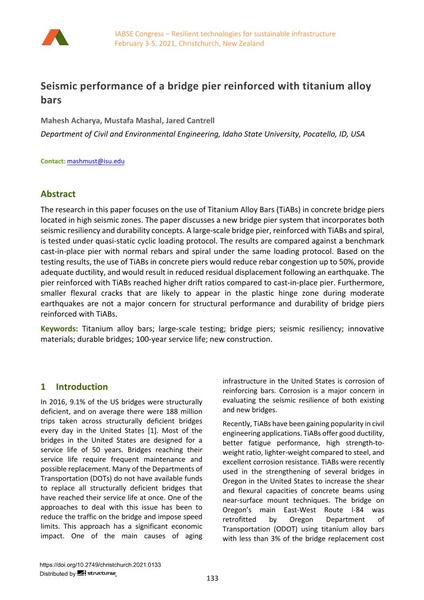Seismic performance of a bridge pier reinforced with titanium alloy bars

|
|
|||||||||||
Bibliographic Details
| Author(s): |
Mahesh Acharya
(Department of Civil and Environmental Engineering, Idaho State University, Pocatello, ID, USA)
Mustafa Mashal (Department of Civil and Environmental Engineering, Idaho State University, Pocatello, ID, USA) Jared Cantrell (Department of Civil and Environmental Engineering, Idaho State University, Pocatello, ID, USA) |
||||
|---|---|---|---|---|---|
| Medium: | conference paper | ||||
| Language(s): | English | ||||
| Conference: | IABSE Congress: Resilient technologies for sustainable infrastructure, Christchurch, New Zealand, 3-5 February 2021 | ||||
| Published in: | IABSE Congress Christchurch 2020 | ||||
|
|||||
| Page(s): | 133-139 | ||||
| Total no. of pages: | 7 | ||||
| DOI: | 10.2749/christchurch.2021.0133 | ||||
| Abstract: |
The research in this paper focuses on the use of Titanium Alloy Bars (TiABs) in concrete bridge piers located in high seismic zones. The paper discusses a new bridge pier system that incorporates both seismic resiliency and durability concepts. A large-scale bridge pier, reinforced with TiABs and spiral, is tested under quasi-static cyclic loading protocol. The results are compared against a benchmark cast-in-place pier with normal rebars and spiral under the same loading protocol. Based on the testing results, the use of TiABs in concrete piers would reduce rebar congestion up to 50%, provide adequate ductility, and would result in reduced residual displacement following an earthquake. The pier reinforced with TiABs reached higher drift ratios compared to cast-in-place pier. Furthermore, smaller flexural cracks that are likely to appear in the plastic hinge zone during moderate earthquakes are not a major concern for structural performance and durability of bridge piers reinforced with TiABs. |
||||
| Keywords: |
new construction large-scale testing bridge piers Innovative Materials Titanium alloy bars seismic resiliency durable bridges 100-year service life
|
||||
